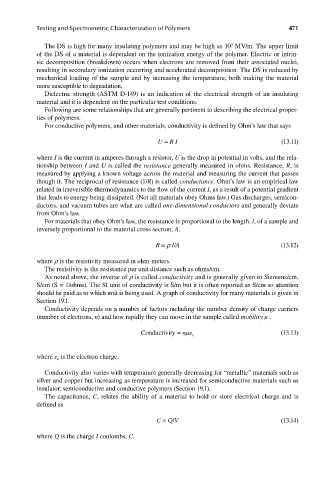Page 508 - Carrahers_Polymer_Chemistry,_Eighth_Edition
P. 508
Testing and Spectrometric Characterization of Polymers 471
3
The DS is high for many insulating polymers and may be high as 10 MV/m. The upper limit
of the DS of a material is dependent on the ionization energy of the polymer. Electric or intrin-
sic decomposition (breakdown) occurs when electrons are removed from their associated nuclei,
resulting in secondary ionization occurring and accelerated decomposition. The DS is reduced by
mechanical loading of the sample and by increasing the temperature, both making the material
more susceptible to degradation.
Dielectric strength (ASTM D-149) is an indication of the electrical strength of an insulating
material and it is dependent on the particular test conditions.
Following are some relationships that are generally pertinent to describing the electrical proper-
ties of polymers.
For conductive polymers, and other materials, conductivity is defined by Ohm’s law that says
U = R I (13.11)
where I is the current in amperes through a resistor, U is the drop in potential in volts, and the rela-
tionship between I and U is called the resistance generally measured in ohms. Resistance, R, is
measured by applying a known voltage across the material and measuring the current that passes
though it. The reciprocal of resistance (1/R) is called conductance. Ohm’s law is an empirical law
related in irreversible thermodynamics to the flow of the current I, as a result of a potential gradient
that leads to energy being dissipated. (Not all materials obey Ohms law.) Gas discharges, semicon-
ductors, and vacuum tubes are what are called one-dimensional conductors and generally deviate
from Ohm’s law.
For materials that obey Ohm’s law, the resistance is proportional to the length, l, of a sample and
inversely proportional to the material cross section, A.
R = ρ l/A (13.12)
where ρ is the resistivity measured in ohm-meters.
The resistivity is the resistance per unit distance such as ohms/cm.
As noted above, the inverse of ρ is called conductivity and is generally given in Siemens/cm,
S/cm (S = 1/ohms). The SI unit of conductivity is S/m but it is often reported as S/cm so attention
should be paid as to which unit is being used. A graph of conductivity for many materials is given in
Section 19.1.
Conductivity depends on a number of factors including the number density of charge carriers
(number of electrons, n) and how rapidly they can move in the sample called mobility µ .
Conductivity = nµe (13.13)
c
where e is the electron charge.
c
Conductivity also varies with temperature generally decreasing for “metallic” materials such as
silver and copper but increasing as temperature is increased for semiconductive materials such as
insulator, semiconductive and conductive polymers (Section 19.1).
The capacitance, C, relates the ability of a material to hold or store electrical charge and is
defi ned as
C = Q/V (13.14)
where Q is the charge I coulombs, C.
9/14/2010 3:42:18 PM
K10478.indb 471 9/14/2010 3:42:18 PM
K10478.indb 471

